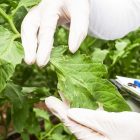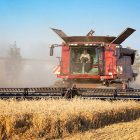
Soil treatment
Soil health is defined as the continued capacity of a soil to function as a vital living ecosystem that sustains plants, animals and humans. These functions include maintaining plant productivity, regulating and partitioning water, filtering and buffering against pollutants, and storing and cycling nutrients.
Soil health as we know it depends on management and generally boils down to organic matter and porosity, two physical properties that are highly dependent on soil texture. When we have higher organic matter we have, greater water infiltration, lower bulk density, higher EC (Electro Conductivity), higher respiration, greater soil nitrogen, greater aggregate stability, more earthworms and more soil microbes.
To improve soil health farmers should consider implementing a practice or combination of practices that depend on soil texture, soil health status, and constraints of their farming system. The practices include minimizing disturbance, maximize time with living roots, keep the soil covered, and diversifying rotations.
Principles to Improve Soil Health
Minimize Disturbance
From hooves to plows, soil is disturbed in many ways. While some disturbance is unavoidable, minimizing disturbance events across your operation builds healthier soils.
To minimize disturbance of your soil, you can:
- Limit tillage
- Optimize chemical input
- Rotate livestock
Maximize Soil Cover
As a general rule, soil should be covered whenever possible. You can plant cover crops as part of both grazing and cropland operations.
To maximize soil cover year round, you can:
- Plant cover crops
- Use organic mulch
- Leave plant residue
Maximize Biodiversity
Increasing diversity across your operation can break disease cycles, stimulate plant growth, and provide habitat for pollinators and organisms living in your soil.
- Plant diverse cover crops
- Use diverse crop rotations
- Integrate livestock
Maximize Presence of Living Roots
Living roots reduce soil erosion and provide food for organisms like earthworms and microbes that cycle the nutrients you plants need.
- Reduce fallow
- Plant cover crops
- Use diverse crop rotations



